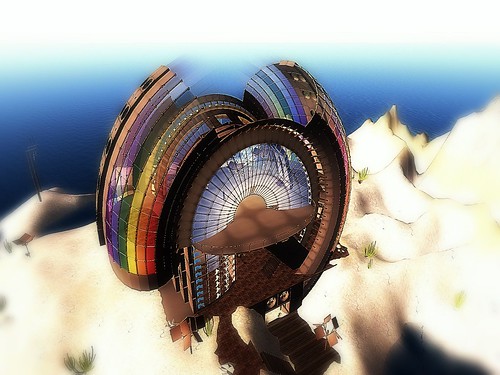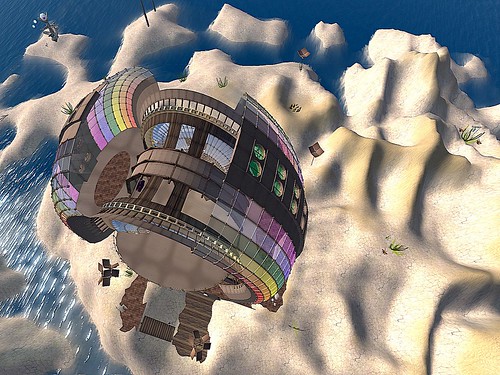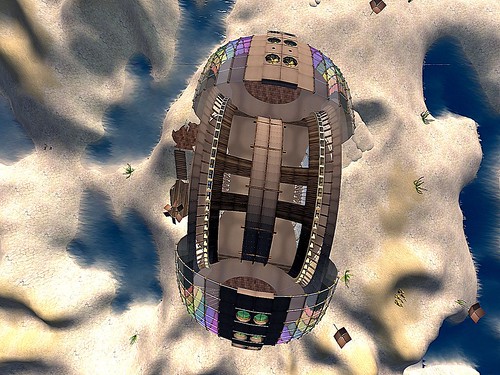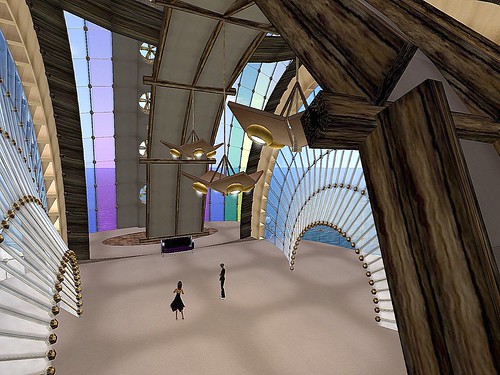Among other things, you might say that Scope Cleaver's newest building looks like a rainbow colored Chambered Nautilus, or a prized Wurlitzer jukebox. You might remark on its open roof, or how it throws off light beams. But it is a foregone conclusion that you will not say that you have ever seen any other building like it before. In any life. Fact is, if you want to acquaint yourself with typical architecture in Second Life®, do not teleport here. 
Princeton commissioned the creation of this pixelated building, which it subsequently named Diversity
I met with Scope in March to see how the building was progressing, and then followed that up with an interview this weekend.
This is so very different for you!
Scope Cleaver: Yes, the materials are pretty different... lots of adobe, woods and brass. A combination I haven't used before in Second Life. The goal was to create a building that would be environmentally friendly in Real Life, so I introduced wind turbines and the use of energy-conscious materials.
Well, we can set examples in-world for off-world construction. Have you ever seen a structure that combines these materials?
Scope Cleaver: Not in the same mix, no. I've seen wood and adobe together before, of course, but not with brass and colored glass. Maybe this has been done in the steampunk sims, though I don't know. First time I dare use so much color. 
Tell me about the evolution of your thought process regarding design.
Scope Cleaver: I started designing in Second Life as a way to see where the tools would bring me and learn about its limitations, and more importantly how those limitations and constraints could help me find a new perspective and ways of expression.
I think a defining trait in my thinking about design in Second Life is to take it seriously as an object of study and research. There is a complex web of variables that inspires design in the study of culture, how avatars interact, the economy, people's sense of space and privacy, language (because yes, that too is evolving in it's own way), technology, meaning and values. I believe (that) trying to be sensitive to it all - on a global scale - helps shape how I would like to evolve with architecture in Second Life.
Hmmm, though the terraforming by Poid Mahovlich is overrated
Your work is becoming more NPIRL (Not Possible in Real Life) all the time. Did NPIRL have any influence on you in this regard?
Scope Cleaver: I don't really have imperatives before making a design on whether it should be possible or translate in Real Life or not. I am not sure it's the right way to compare things for many reasons, one of which is, it isn't clear in our still incomplete physics what is and isn't possible in Real Life.
What if we find in 20 years that X is indeed possible in Real Life after all? Should it change the value of a piece in Second Life? Also, in Second Life, I may have seen buildings that defy the law of gravity, but I have yet to see any that defy the laws of logic. So what does it mean exactly to be impossible IRL? And what does it teach us about RL/SL? If we really put our minds to it, could we come up with something we thought was impossible, yet manage to make it in Real Life? Where there is no doubt, is that Second Life does reveal to me new possibilities on a daily basis. In this sense, many inspiring creators in the group have left me in constant amazement.
Artist and architect Santiago Calatrava's planned "Obelisco" for Madrid would certainly add strength to Scope's argument
What were your biggest challenges in creating this building and how did you go about tackling them?
Scope Cleaver: Well, I'll attempt to gracefully avoid talking about prim management... But one interesting challenge was to figure out how I would bring together elements which are usually seen together in a different aesthetic repertoire. I am talking here about materials, colors and the general tone of the building. I used simple trial and error methods and experimented with many different iterations, until I was happy with it. There was a bit of wrestling with myself, and some exploring and learning was in order, since this departs from my usual style. It's never easy to face the unknown.
What are your plans for the future?
Scope Cleaver: I have a few smaller artistic projects along with a custom residence on my plate for the immediate future. For the long term, I plan to live long enough to witness a revolution in how we think about designs as sentient entities; more on that in a few years...
What would you like to be doing that you have not had the opportunity to do yet?
Scope Cleaver: I have been very lucky to get plenty of opportunities from clients to realize things with very few constraints. I guess one thing I would like is design a space for a think tank or research center focused on the future of virtual worlds and artificial intelligence.
What are a couple of the biggest differences between designing for Real Life and Second Life...
Scope Cleaver: There is the obvious, like deterioration, the likelihood of a civil lawsuit and the order of magnitude involved in the program and timetables, and plenty of details about manufacturing processes and the cost involved in items that are designed for mass production. If you strip to the essentials though, I tend to notice there are more similarities than differences.
Which creators in Second Life inspire you and why?
Scope Cleaver: There are way too many to list. I have the utmost admiration and get inspiration from Seifert Surface for his expertise and wise words: "sometimes magic doesn't work." We share a passion for mathematics and art. Keystone Bouchard, for his constantly evolving insights about architecture, interactivity and collaboration.
Lately, from AldoManutio Abruzzo whose music inspires elegance and expanses of space. Lem Skall, for his amazing photography and sense of composition... a true Second Life explorer. DB Bailey, for his ability to carve space and make abstractions tangible. Patch Thibaud for his efficiency and the ease in implementing a design. The people who come to see me build, for their gems of comments and quirks, and many others... 
One of the differences between Real Life architecture and Second Life architecture is that it is so much easier to sell virtual duplicates of a work, much like lithographs or prints. This places Second Life architecture in a saleabilty category that is similar to commercial art in Real Life. Do you agree?
Scope Cleaver: I see this as a fact so it's difficult to disagree with it. I do both. I have some of my buildings for sale and others I do custom, although my work is mostly custom. I think there is a future for both. Putting aside the philosophical issue of the value of the many versus the unique, there certainly is a demand for both. The reason I prefer custom is because it feels much more personal, and you get to interact on the creative level with the client throughout the project. That said, it would make more business sense to focus entirely on selling duplicates, which in Second Life we call "prefabs".
See also: Scope Cleaver's winged superstructure
Tuesday, June 3, 2008
A most extraordinary building in Second Life
Posted by
Bettina Tizzy
at
9:39 PM
![]()
Labels: adobe, architecture, brass, design, glass, Not Possible IRL, NPIRL, Princeton University, Santiago Calatrava, Scope Cleaver, Second Life®, virtual worlds, wood








2 comments:
Interesting building and interesting article. I'm an architect in Dubai and this sort of thinking excites me. I am not a client of Second Life, but this sort of thing could convince me. It doesn't seem like such a waste of time when you look at it this way.
HW
This is one of my favorite structures in all of SL! I'm glad to hear what the architect has to say. Fascinating :)
Post a Comment